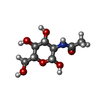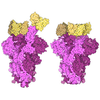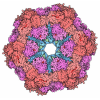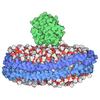+ Open data
Open data
- Basic information
Basic information
| Entry | Database: PDB / ID: 9nrc | ||||||
|---|---|---|---|---|---|---|---|
| Title | TMPRSS6 in complex with REGN7999 Fab and REGN8023 Fab | ||||||
 Components Components |
| ||||||
 Keywords Keywords | MEMBRANE PROTEIN / Serine protease / Matriptase | ||||||
| Function / homology |  Function and homology information Function and homology informationmembrane protein proteolysis / self proteolysis / Collagen degradation / collagen catabolic process / Hydrolases; Acting on peptide bonds (peptidases); Serine endopeptidases / extracellular matrix disassembly / negative regulation of BMP signaling pathway / BMP signaling pathway / Degradation of the extracellular matrix / metalloendopeptidase activity ...membrane protein proteolysis / self proteolysis / Collagen degradation / collagen catabolic process / Hydrolases; Acting on peptide bonds (peptidases); Serine endopeptidases / extracellular matrix disassembly / negative regulation of BMP signaling pathway / BMP signaling pathway / Degradation of the extracellular matrix / metalloendopeptidase activity / multicellular organismal-level iron ion homeostasis / intracellular iron ion homeostasis / serine-type endopeptidase activity / negative regulation of DNA-templated transcription / negative regulation of transcription by RNA polymerase II / positive regulation of transcription by RNA polymerase II / extracellular space / plasma membrane Similarity search - Function | ||||||
| Biological species |  Homo sapiens (human) Homo sapiens (human) | ||||||
| Method | ELECTRON MICROSCOPY / single particle reconstruction / cryo EM / Resolution: 3.29 Å | ||||||
 Authors Authors | Saotome, K. / Franklin, M.C. | ||||||
| Funding support | 1items
| ||||||
 Citation Citation |  Journal: JCI Insight / Year: 2025 Journal: JCI Insight / Year: 2025Title: A TMPRSS6-inhibiting mAb improves disease in a β-thalassemia mouse model and reduces iron in healthy humans. Authors: Heinrich E Lob / Nikhil Singh / Kusha Mohammadi / Larisa Ivanova / Beth Crowell / Hyon J Kim / Leah Kravets / Nanditha M Das / Yonaton Ray / Jee Hae Kim / Sylvie Rottey / Emily Labriola- ...Authors: Heinrich E Lob / Nikhil Singh / Kusha Mohammadi / Larisa Ivanova / Beth Crowell / Hyon J Kim / Leah Kravets / Nanditha M Das / Yonaton Ray / Jee Hae Kim / Sylvie Rottey / Emily Labriola-Tompkins / Hazem E Hassan / Lorna Farrelly / Harvey F Chin / Marilena Preda / Leigh Spencer Noakes / Kei Saotome / Matthew Franklin / Marc W Retter / Elif Karayusuf / John J Flanagan / William Olson / Kalyan C Nannuru / Vincent Idone / Michael E Burczynski / Olivier A Harari / Lorah Perlee / Griet Van Lancker / Andrew J Murphy / Aris N Economides / Sarah J Hatsell /   Abstract: β-Thalassemia is a genetic disorder arising from mutations in the β-globin gene, leading to ineffective erythropoiesis and iron overload. Ineffective erythropoiesis, a hallmark of β-thalassemia, ...β-Thalassemia is a genetic disorder arising from mutations in the β-globin gene, leading to ineffective erythropoiesis and iron overload. Ineffective erythropoiesis, a hallmark of β-thalassemia, is an important driver of iron overload, which contributes to liver fibrosis, diabetes, and cardiac disease. Iron homeostasis is regulated by the hormone hepcidin; BMP6/hemojuvelin-mediated (BMP6/HJV-mediated) signaling induces hepatic hepcidin expression via SMAD1/5, with transmembrane serine protease 6 (TMPRSS6) being a negative regulator of HJV. Individuals with loss-of-function mutations in the TMPRSS6 gene show increased circulating hepcidin and iron-refractory iron-deficiency anemia, suggesting that blocking TMPRSS6 may be a viable strategy to elevate hepcidin levels in β-thalassemia. We generated a human mAb (REGN7999) that inhibits TMPRSS6. In an Hbbth3/+ mouse model of β-thalassemia, REGN7999 treatment led to significant reductions in liver iron, reduced ineffective erythropoiesis, and showed improvements in RBC health, running distance during forced exercise, and bone density. In a phase I, doubleblind, randomized, placebo-controlled study in healthy human volunteers (NCT05481333), REGN7999 increased serum hepcidin and reduced serum iron with an acceptable tolerability profile. Our results suggest that, by both reducing iron and improving RBC function, inhibition of TMPRSS6 by REGN7999 may offer a therapy for iron overload and impaired erythropoiesis in β-thalassemia. #1: Journal: Acta Crystallogr D Struct Biol / Year: 2019 Title: Macromolecular structure determination using X-rays, neutrons and electrons: recent developments in Phenix. Authors: Dorothee Liebschner / Pavel V Afonine / Matthew L Baker / Gábor Bunkóczi / Vincent B Chen / Tristan I Croll / Bradley Hintze / Li Wei Hung / Swati Jain / Airlie J McCoy / Nigel W Moriarty ...Authors: Dorothee Liebschner / Pavel V Afonine / Matthew L Baker / Gábor Bunkóczi / Vincent B Chen / Tristan I Croll / Bradley Hintze / Li Wei Hung / Swati Jain / Airlie J McCoy / Nigel W Moriarty / Robert D Oeffner / Billy K Poon / Michael G Prisant / Randy J Read / Jane S Richardson / David C Richardson / Massimo D Sammito / Oleg V Sobolev / Duncan H Stockwell / Thomas C Terwilliger / Alexandre G Urzhumtsev / Lizbeth L Videau / Christopher J Williams / Paul D Adams /    Abstract: Diffraction (X-ray, neutron and electron) and electron cryo-microscopy are powerful methods to determine three-dimensional macromolecular structures, which are required to understand biological ...Diffraction (X-ray, neutron and electron) and electron cryo-microscopy are powerful methods to determine three-dimensional macromolecular structures, which are required to understand biological processes and to develop new therapeutics against diseases. The overall structure-solution workflow is similar for these techniques, but nuances exist because the properties of the reduced experimental data are different. Software tools for structure determination should therefore be tailored for each method. Phenix is a comprehensive software package for macromolecular structure determination that handles data from any of these techniques. Tasks performed with Phenix include data-quality assessment, map improvement, model building, the validation/rebuilding/refinement cycle and deposition. Each tool caters to the type of experimental data. The design of Phenix emphasizes the automation of procedures, where possible, to minimize repetitive and time-consuming manual tasks, while default parameters are chosen to encourage best practice. A graphical user interface provides access to many command-line features of Phenix and streamlines the transition between programs, project tracking and re-running of previous tasks. | ||||||
| History |
|
- Structure visualization
Structure visualization
| Structure viewer | Molecule:  Molmil Molmil Jmol/JSmol Jmol/JSmol |
|---|
- Downloads & links
Downloads & links
- Download
Download
| PDBx/mmCIF format |  9nrc.cif.gz 9nrc.cif.gz | 388.6 KB | Display |  PDBx/mmCIF format PDBx/mmCIF format |
|---|---|---|---|---|
| PDB format |  pdb9nrc.ent.gz pdb9nrc.ent.gz | 249 KB | Display |  PDB format PDB format |
| PDBx/mmJSON format |  9nrc.json.gz 9nrc.json.gz | Tree view |  PDBx/mmJSON format PDBx/mmJSON format | |
| Others |  Other downloads Other downloads |
-Validation report
| Summary document |  9nrc_validation.pdf.gz 9nrc_validation.pdf.gz | 1.4 MB | Display |  wwPDB validaton report wwPDB validaton report |
|---|---|---|---|---|
| Full document |  9nrc_full_validation.pdf.gz 9nrc_full_validation.pdf.gz | 1.4 MB | Display | |
| Data in XML |  9nrc_validation.xml.gz 9nrc_validation.xml.gz | 53.8 KB | Display | |
| Data in CIF |  9nrc_validation.cif.gz 9nrc_validation.cif.gz | 82 KB | Display | |
| Arichive directory |  https://data.pdbj.org/pub/pdb/validation_reports/nr/9nrc https://data.pdbj.org/pub/pdb/validation_reports/nr/9nrc ftp://data.pdbj.org/pub/pdb/validation_reports/nr/9nrc ftp://data.pdbj.org/pub/pdb/validation_reports/nr/9nrc | HTTPS FTP |
-Related structure data
| Related structure data |  49728MC M: map data used to model this data C: citing same article ( |
|---|---|
| Similar structure data | Similarity search - Function & homology  F&H Search F&H Search |
- Links
Links
- Assembly
Assembly
| Deposited unit | 
|
|---|---|
| 1 |
|
- Components
Components
-Antibody , 4 types, 4 molecules LHBC
| #2: Antibody | Mass: 23381.912 Da / Num. of mol.: 1 Source method: isolated from a genetically manipulated source Source: (gene. exp.)  Homo sapiens (human) / Production host: Homo sapiens (human) / Production host:  |
|---|---|
| #3: Antibody | Mass: 25604.521 Da / Num. of mol.: 1 Source method: isolated from a genetically manipulated source Source: (gene. exp.)  Homo sapiens (human) / Production host: Homo sapiens (human) / Production host:  |
| #4: Antibody | Mass: 24117.859 Da / Num. of mol.: 1 Source method: isolated from a genetically manipulated source Source: (gene. exp.)  Homo sapiens (human) / Production host: Homo sapiens (human) / Production host:  |
| #5: Antibody | Mass: 25308.553 Da / Num. of mol.: 1 Source method: isolated from a genetically manipulated source Source: (gene. exp.)  Homo sapiens (human) / Production host: Homo sapiens (human) / Production host:  |
-Protein / Non-polymers , 2 types, 4 molecules A

| #1: Protein | Mass: 85154.820 Da / Num. of mol.: 1 / Mutation: S762A Source method: isolated from a genetically manipulated source Source: (gene. exp.)  Homo sapiens (human) / Gene: TMPRSS6, UNQ354/PRO618 / Production host: Homo sapiens (human) / Gene: TMPRSS6, UNQ354/PRO618 / Production host:  References: UniProt: Q8IU80, Hydrolases; Acting on peptide bonds (peptidases); Serine endopeptidases |
|---|---|
| #8: Chemical |
-Sugars , 2 types, 6 molecules 
| #6: Polysaccharide | Source method: isolated from a genetically manipulated source #7: Sugar | |
|---|
-Details
| Has ligand of interest | N |
|---|---|
| Has protein modification | Y |
-Experimental details
-Experiment
| Experiment | Method: ELECTRON MICROSCOPY |
|---|---|
| EM experiment | Aggregation state: PARTICLE / 3D reconstruction method: single particle reconstruction |
- Sample preparation
Sample preparation
| Component | Name: TMPRSS6 in complex with REGN7999 Fab and REGN8023 Fab / Type: COMPLEX / Entity ID: #1-#5 / Source: RECOMBINANT |
|---|---|
| Molecular weight | Experimental value: NO |
| Source (natural) | Organism:  Homo sapiens (human) Homo sapiens (human) |
| Source (recombinant) | Organism:  |
| Buffer solution | pH: 7.5 |
| Specimen | Embedding applied: NO / Shadowing applied: NO / Staining applied: NO / Vitrification applied: YES |
| Vitrification | Cryogen name: ETHANE |
- Electron microscopy imaging
Electron microscopy imaging
| Experimental equipment |  Model: Titan Krios / Image courtesy: FEI Company |
|---|---|
| Microscopy | Model: TFS KRIOS |
| Electron gun | Electron source:  FIELD EMISSION GUN / Accelerating voltage: 300 kV / Illumination mode: FLOOD BEAM FIELD EMISSION GUN / Accelerating voltage: 300 kV / Illumination mode: FLOOD BEAM |
| Electron lens | Mode: BRIGHT FIELD / Nominal defocus max: 2200 nm / Nominal defocus min: 1200 nm |
| Image recording | Electron dose: 40 e/Å2 / Film or detector model: GATAN K3 BIOQUANTUM (6k x 4k) |
- Processing
Processing
| EM software | Name: PHENIX / Version: 1.21.1_5286 / Category: model refinement | ||||||||||||||||||||||||
|---|---|---|---|---|---|---|---|---|---|---|---|---|---|---|---|---|---|---|---|---|---|---|---|---|---|
| CTF correction | Type: PHASE FLIPPING AND AMPLITUDE CORRECTION | ||||||||||||||||||||||||
| 3D reconstruction | Resolution: 3.29 Å / Resolution method: FSC 0.143 CUT-OFF / Num. of particles: 105142 / Symmetry type: POINT | ||||||||||||||||||||||||
| Refinement | Cross valid method: NONE Stereochemistry target values: GeoStd + Monomer Library + CDL v1.2 | ||||||||||||||||||||||||
| Displacement parameters | Biso mean: 84.51 Å2 | ||||||||||||||||||||||||
| Refine LS restraints |
|
 Movie
Movie Controller
Controller



 PDBj
PDBj







